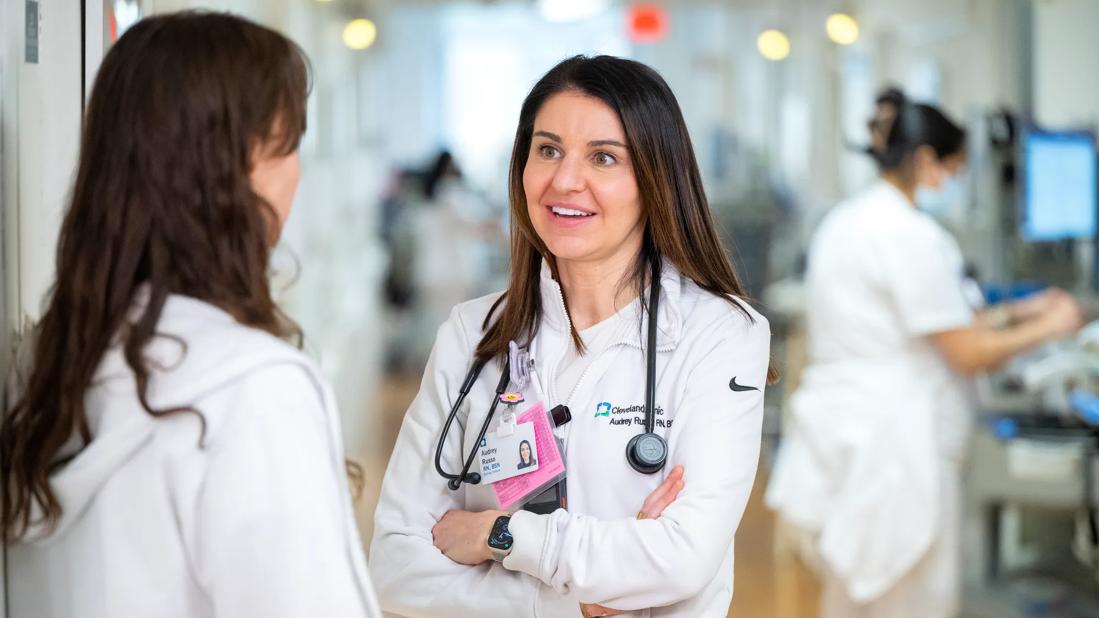Project aims to improve patient care by streamlining caregiver transitions

Nurses in the Neurological Intensive Care Unit (Neuro ICU) work with critically ill patients in a dynamic and complex environment. For these skilled caregivers, one of the most pivotal parts of the day is handoff – the period at the end of every shift during which the on-duty nurse must relay important clinical information to the incoming nurse. To be successful, these transitions must be succinct, and any changes to patients’ neurological status, medication needs and monitoring requirements must be clearly communicated.
Advertisement
Cleveland Clinic is a non-profit academic medical center. Advertising on our site helps support our mission. We do not endorse non-Cleveland Clinic products or services. Policy
Preventing unnecessary interruptions is key to ensuring that nurses understand the full clinical picture and are prepared to provide the safest, highest-quality care, explains Claire Miller, BSN, RN, a nurse in the Neuro ICU at Cleveland Clinic’s Main Campus.
“We know that handoff is the most critical point of any ICU nurse’s day,” Miller says. “Maintaining good communication during this period promotes better continuity of care, and mistakes can happen if the handoff process is incomplete, rushed or interrupted.”
Recognizing an opportunity to support caregivers during shift changes, Miller and her nursing colleague and project co-leader Ashley Linek, BSN, RN, launched an initiative to better understand and reduce interruptions during handoffs. They began by asking both day- and night-shift nurses in the Neuro ICU to complete two brief, anonymous surveys about the types of interruptions that can occur during handoffs.
"Each handoff serves as a bridge that connects caregivers and prevents errors and omissions that can compromise patient outcomes,” Linek notes. “A clear, focused process can empower nurses to deliver seamless care, but success demands that every detail about the patient’s condition and care plan is accurately conveyed. Claire and I realized that understanding the kinds of delays and interruptions that most frequently arise would be a key step in developing solutions.”
The initial survey, which took about 30 seconds to complete, invited nurses to share about handoff interruptions they observed over a three-week period. It also asked respondents to categorize interruptions by type: monitor alarms, IV pumps, provider updates, caregiver conversations, and nonurgent phone calls, for example. This enabled Miller and Linek to distinguish between necessary and unnecessary disruptions.
Advertisement
After analyzing the survey data, Miller and Linek developed targeted educational materials focused on strategies to minimize common handoff interruptions. The information, which focused on best practices for limiting interruptions, was discussed in pre-shift huddles. The materials were also emailed to nurses within the Neuro ICU, encouraging them to help create an environment that treats handoffs as protected time.
For example, caregivers are instructed to triage phone calls to determine their urgency. “In many cases, the matter can wait until after handoff is complete,” Miller says.
Miller and Linek also helped create high-visibility “Handoff in Progress” signs that encourage families to refrain from visiting from 6-8 a.m. and 6-8 p.m. Health unit coordinators are also encouraged to perform rounds before each handoff and ask visitors to step out during the critical period.
“We’re working in an ICU, so we can’t expect to eliminate interruptions entirely, but we wanted to do what we could to reduce preventable distractions and keep unavoidable interruptions from being so time-consuming,” Linek explains.
Six months after launching their educational initiative, Miller and Linek redistributed their survey to assess any changes in the type and frequency of handoff interruptions. Linek says they were thrilled to see that overall interruptions had decreased by 12%.
In the near future, the pair hope to collaborate with other units across the Cleveland Clinic enterprise to expand the initiative and share what they’ve learned. Miller and Linek, who both serve on their unit-based shared governance council, presented their project at Cleveland Clinic’s 2024 Zielony Nursing Institute Shared Governance Conference.
Advertisement
“Our survey and educational materials were designed to be easily adapted by other units,” Miller says. “Because handoff interruptions can occur across all specialties, the framework we've developed offers a scalable approach that nursing teams can tailor to their specific needs.”
“We consider ourselves lucky,” Linek adds. “Cleveland Clinic has given us the resources and support we need to try a new approach that is improving patient care while enabling nurses to take better care of themselves.”
Advertisement
Advertisement

How hospitals can weave ethics into daily nursing practice to strengthen patient-centered care

Mobility carts provide exercises and tools

Nurse researchers explore the relationship between readmission risk scores and acute care transfers

Guiding nurses amid a constantly evolving healthcare landscape

Ideation session generates solutions to medication administration errors

Caregivers spearhead changes that improve patient care, shape hospital culture

Building a culture that supports, engages and empowers nursing staff

Nurses harness cutting-edge technology as a bridge to healing